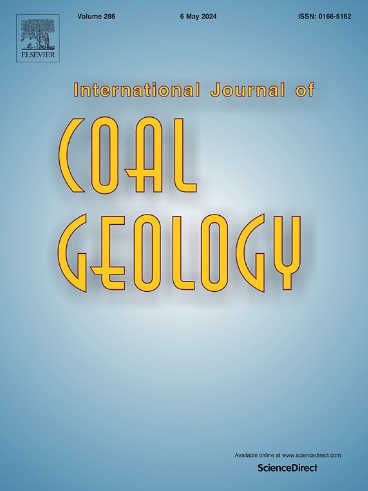Petrological, mineralogical, and geochemical compositions of the Eocene coals from Senakin Peninsula, South Kalimantan, Indonesia
IF 5.7
2区 工程技术
Q2 ENERGY & FUELS
引用次数: 0
Abstract
Samples from the Senakin coal bed (Eocene age, Pasir Sub-basin) were analyzed to study the concentration of critical elements and investigate genetic types and enrichment processes. Of particular interest was to determine if an overlying mafic volcanic unit dated to the same age as the overlying Eocene sediments and tonstein layers withing the coal, affected the geochemical composition of the coal bed. Five partings were identified as being mafic-alkali tonsteins. The lower and upper tonsteins are interpreted to originate both from volcanic ash-fall material intermingled with water-borne detrital sediments. The middle tonstein is thought to have originated primarily as an ash-fall. A consistent feature of all partings, however, is that they are characterized by a graupen texture with additional vermicular and vitroclastic textures. The coal samples from the Senakin coal bed are dominated by vitrinite (64 vol%) with subordinate proportions of liptinite (29 vol%), and inertinite (7 vol%). Optical and SEM-EDX measurements of the coal samples showed that the inorganic material is dominantly pyrite, marcasite, quartz, kaolinite, illite, apatite, calcite, Ti oxides, Ti-V-bearing minerals, and a Mo-bearing mineral. Some coal samples from the Senakin coal bed have total rare earth element and yttrium (REY) concentrations up to 283.53 ppm. Furthermore, coals are enriched in REY and some trace elements (e.g., Zr (Hf), Nb (Ta), Ga, Sr, and V). It is hypothesized that the critical enrichments of the Senakin coal bed may be controlled primarily by three factors: (1) mafic-intermediate volcaniclastic rocks whose provenance are possibly from the Pitap and Haruyan Formations, (2) marine water infiltration from overlying sediments into recently buried peat, and/or (3) the occurrence mafic-alkali tonstein layers.
印度尼西亚南加里曼丹Senakin半岛始新世煤的岩石学、矿物学和地球化学组成
对巴西亚盆地始新世Senakin煤层样品进行了分析,研究了关键元素的浓度、成因类型和富集过程。特别感兴趣的是确定上覆的基性火山单元是否与上覆的始新世沉积物和煤内的顿斯坦层的年代相同,影响了煤层的地球化学组成。鉴定出5个分型为基碱结晶。下部和上部的岩石被解释为起源于火山灰落物和水中碎屑沉积物的混合。人们认为,中部火山主要起源于火山灰落下。然而,所有分离的一个一致的特征是,它们的特征是带有额外的蛭状和碎屑结构的粗粒结构。Senakin煤层煤样以镜质组(64 vol%)为主,其次为脂质组(29 vol%)和惰质组(7 vol%)。煤样的光学和SEM-EDX测量表明,无机物质主要是黄铁矿、马氏石、石英、高岭石、伊利石、磷灰石、方解石、钛氧化物、含钛钒矿物和含钼矿物。Senakin煤层的一些煤样中稀土元素和钇(REY)的总浓度高达283.53 ppm。此外,煤富含REY和微量元素(如Zr (Hf)、Nb (Ta)、Ga、Sr和V)。假设Senakin煤层的临界富集程度主要受3个因素控制:(1)物源可能来自Pitap组和Haruyan组的基性-中间火山碎屑岩,(2)上覆沉积物对新近埋藏泥炭的海水渗透,以及(3)基性-碱顿斯坦层的赋存。
本文章由计算机程序翻译,如有差异,请以英文原文为准。
求助全文
约1分钟内获得全文
求助全文
来源期刊

International Journal of Coal Geology
工程技术-地球科学综合
CiteScore
11.00
自引率
14.30%
发文量
145
审稿时长
38 days
期刊介绍:
The International Journal of Coal Geology deals with fundamental and applied aspects of the geology and petrology of coal, oil/gas source rocks and shale gas resources. The journal aims to advance the exploration, exploitation and utilization of these resources, and to stimulate environmental awareness as well as advancement of engineering for effective resource management.
 求助内容:
求助内容: 应助结果提醒方式:
应助结果提醒方式:


